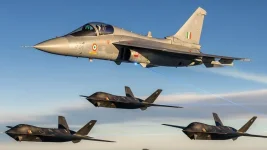Wait and see the defense budget doubling to 150 billion $by 2030 , 400billion by 2040 and 800-one trillion by 2050 in line with GDP growth rates of 8to 10%annually reaching 7 trillion by 2030 ,15 trillion by 2037, 30 trillion by 2045 and may be even 55 trillion by 2050 as predicted by the Chief economic advisor of the govt .
Sir, with all due respect, there is absolutely no way that will happen. The reason for this is rooted in economics and mathematics. GDP does not translate to spending money.
The ratio of central government expenditure to GDP in India is very low, coming in at just over 14%. For reference, in developed economies, that ratio sits at well over 35%, and for nations where the primary source of income is commodity exports, that ratio can go up to as high as 75-80%. Regardless, with the present scenario at 14%, we spend about 13% of central government expenditure on defence, which comes to around 1.9% of GDP spending on defence.
Now, growth in GDP is also faster than growth in government revenues (and by extension, government expenditures). This is simply because a lot of the government revenue comes from consumption taxes (such as the tax one pays on a car). Most consumption growth in India (and therefore a lot of the GDP growth) comes from the private sector, and so the growth in government revenue is far smaller, though somewhat proportional in terms of growth rate rather than growth.
Increasing the defence budget in India requires increasing the government expenditure, and therefore, government revenue. To increase government revenue, there is only one sustainable way: Improve the government revenue to GDP ratio.
Improving the government revenue to GDP ratio would mean bringing in more taxes. This can be done by either taxing more people (that is, increasing the number of taxpayers) or by taxing people more (that is, increasing taxes on the individual taxpayer).
In India, less than 2% of people pay non-zero income taxes, and these people contribute almost 20% of government revenues. There isn't much scope of increasing taxes, since in that case, people will only emigrate or park their wealth elsewhere or vote in a government that will bring taxes down.
Thus, the only way to do this is to increase the taxpayer base. That means increasing the income of people. This has an effect on increasing GDP as well since more income would also help people save more and stimulate more consumption. However, increasing the incomes of people is a very difficult and long-term thing to do.
The reason we are also seeing a drop in the defence spending share of GDP is because a lot of GDP growth has come from the private sector, and because we are now investing into things such as infrastructure that will be needed for improving GDP growth as well as increasing incomes for people.
My projections for India's defence budget, assuming we don't end up in a regional war, are as follows:
2030: Around 90 billion USD. 2040: Around 105 billion USD. 2047: Around 115 billion USD. 2055: Around 125 billion USD.
Reasonable GDP projections are Around 6 trillion USD by 2030, 10 trillion by 2040, and 15 trillion by 2050. That 55 trillion USD may well be the PPP figure adjusted to today.
Maintaining something like a 8% GDP growth on a 4 trillion USD base is far easier than maintaining 8% on a 12 trillion USD GDP. This is simply because the absolute incremental figure goes up that much. If one goes by China's stated figures (which are suspect), they added almost 2.5 times the economic growth of India last year to their economy. In all honesty, even 4% for China or 3.5% for USA is just as, if not more impressive, than 8% for India.





